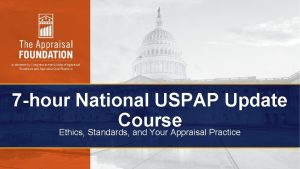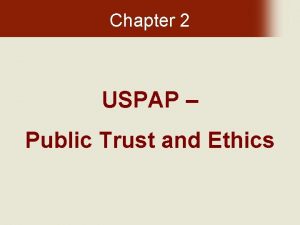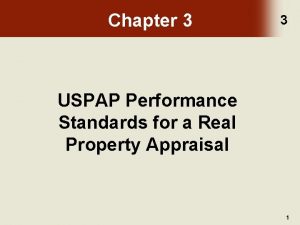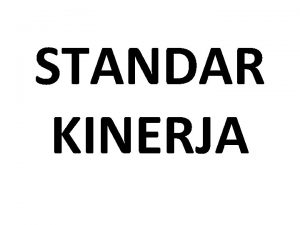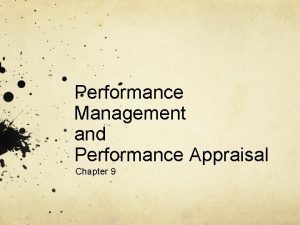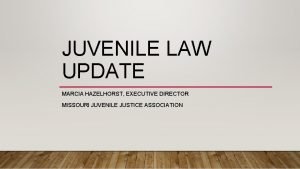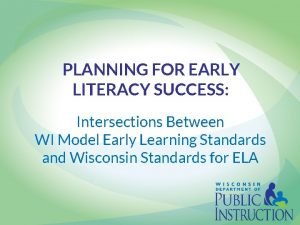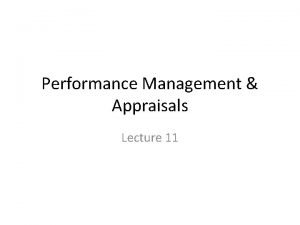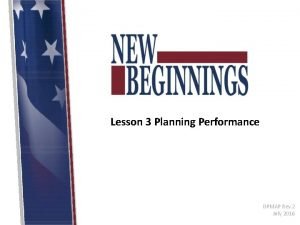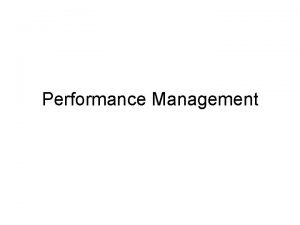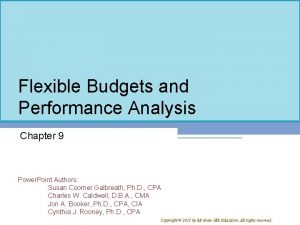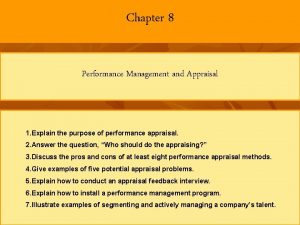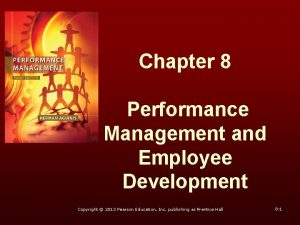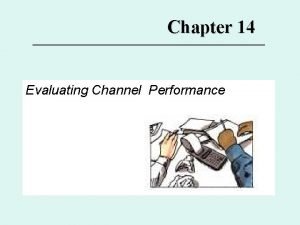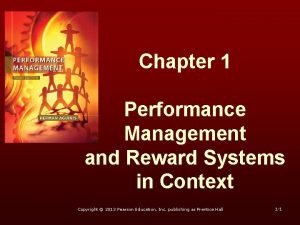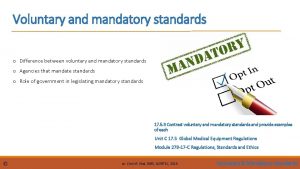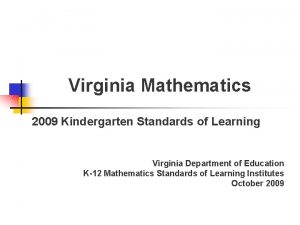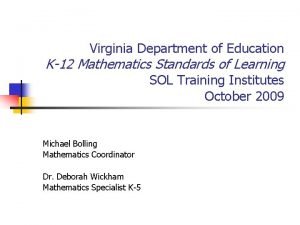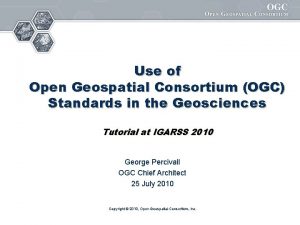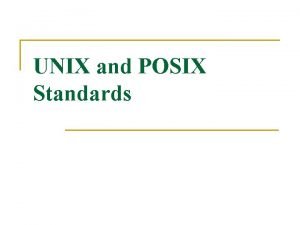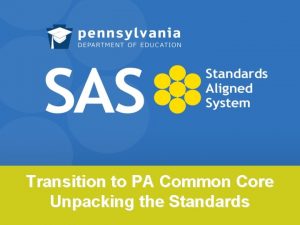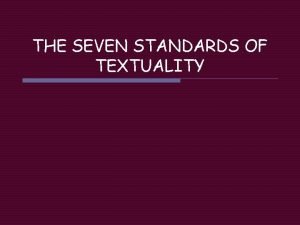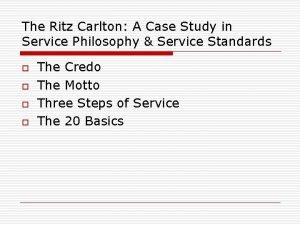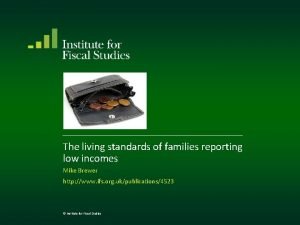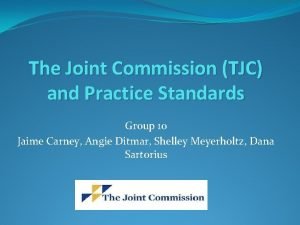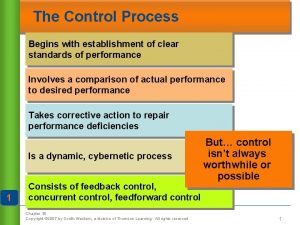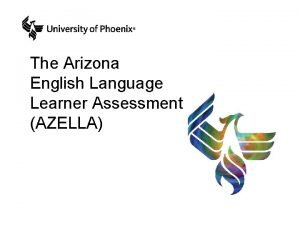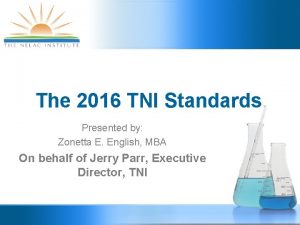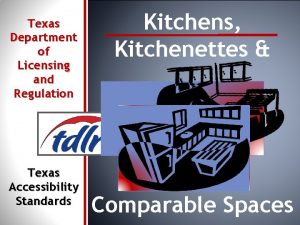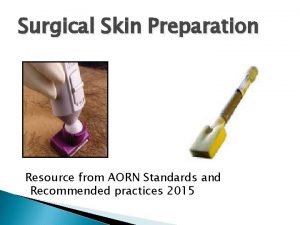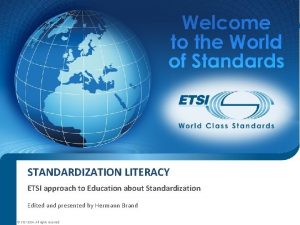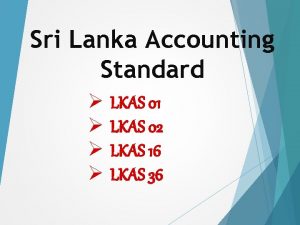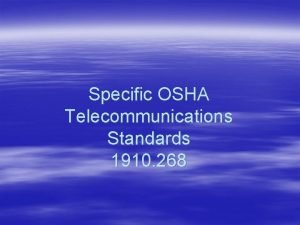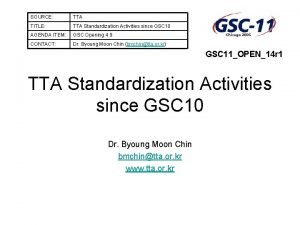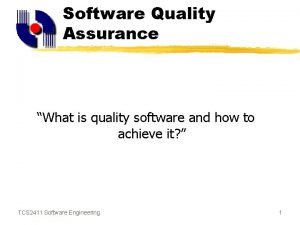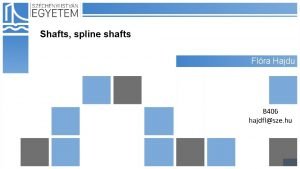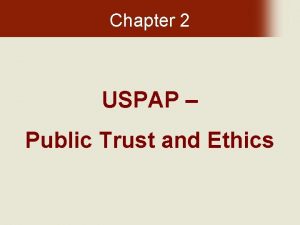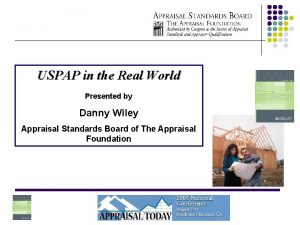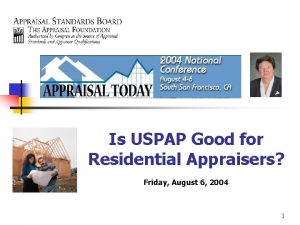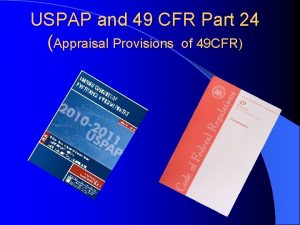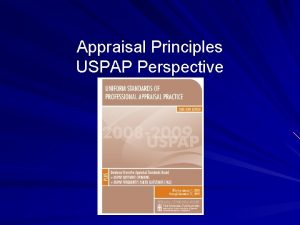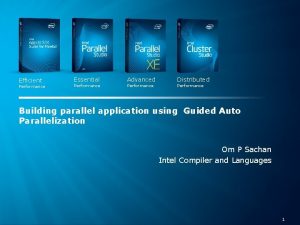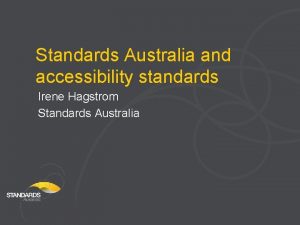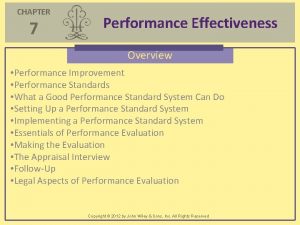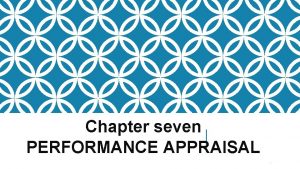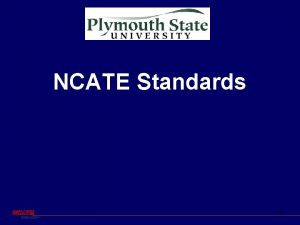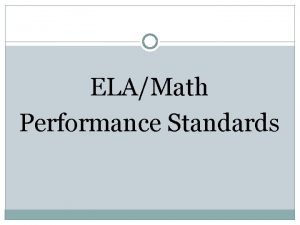Chapter 3 3 USPAP Performance Standards for a















































































































































- Slides: 143

Chapter 3 3 USPAP Performance Standards for a Real Property Appraisal 1

Chapter Objectives 3 • Upon completion of this chapter, the participant will be able to: – Recognize and describe USPAP Performance Standards for a real property appraisal. – Explain the analysis required related to USPAP and Advisory Opinion revisions and the effective date of review assignments. – Differentiate the twp reporting options. 2

Chapter Objectives continued 3 • Upon completion of this chapter, the participant will be able to: – Explain specific obligations of development and reporting, including problem identification, scope of work, intended users, intended use, property characteristics, and property interest. – Differentiate between exposure time and marketing time. – Discuss the difference between effective date and date of report. 3

Chapter Objectives continued 3 • Upon completion of this chapter, the participant will be able to: – Explain scope of work and circumstances in which it may be required to be expanded upon. – Discuss type of analysis required in an assignment, including applicable Standards Rules. – Recognize the reviewer’s tasks in analyzing the sales comparison approach section of the appraisal under review. 4

Chapter Objectives continued 3 • Upon completion of this chapter, the participant will be able to: – Explain the reviewer’s perspective related to highest and best use. – Understand the reviewer’s perspective related to extraordinary assumption and hypothetical condition. – Identify the obligations related to an appraiser’s signed certification in the work under review. 5

Yesterday, Today, and Tomorrow 3 • A review assignment may use the effective date found in the work being reviewed or the assignment may use a different effective date • Use of a different effective date is only possible when the scope of work includes the reviewer developing his own opinion of value, which may use the same or different effective date 6

Yesterday, Today, and continued Tomorrow 3 • When the scope of work includes only expressing an opinion of quality on another appraiser’s work, the effective date of the review report is the same as that found in the work being reviewed – Parts of USPAP applicable in an assignment may be different than those found in the current version, which is a good reason for keeping past USPAP editions for reference 7

Revisions to USPAP 3 • Each new edition of the USPAP document contains a section located within the “Foreword” that is titled “Revisions to USPAP and USPAP Advisory Opinions” 8

Reviewer’s Perspective 3 • Reviewers should familiarize themselves with the Revisions to USPAP and USPAP Advisory Opinions section to use as a quick reference when uncertainty arises regarding USPAP obligations in a particular appraisal review assignment 9

USPAP Version 3 • This course is based upon the 2014 -2015 Edition of USPAP 10

Overview of STANDARDS 1 and 2 3 • STANDARDS 1 and 2 create a road map of performance standards in the appraisal process from problem identification to reporting in a real property review assignment – These standards reflect the minimum obligations for appraisers in the appraisal process 11

Overview of STANDARDS 1 and 2 3 continued • STANDARD 1 establishes criteria for measuring ethics and competency in the development process – Six Standards Rules (1 -1 through 1 -6) • STANDARD 2 addresses reporting in a real property appraisal – Four Standards Rules (2 -1 through 2 -4) 12

Intro Section – STANDARD 1 3 • The introduction to STANDARD 1 states the appraiser’s general obligations related to development of a real property appraisal: – In developing a real property appraisal, an appraiser must identify the problem to be solved, determine the scope of work necessary to solve the problem, and correctly complete research and analyses necessary to produce a credible appraisal 13

Intro Section – STANDARD 2 3 • The introduction to STANDARD 2 reinforces the appraiser’s obligation not to report a real property appraisal in a manner that is misleading: – In reporting the results of a real property appraisal, an appraiser must communicate each analysis, opinion, and conclusion in a manner that is not misleading 14

General Obligations 3 • General requirements for all real property appraisal reports are in Standards Rule 1 -1 – These obligations elaborate (in part) on the general obligations found in the COMPETENCY RULE 15

General Obligations 1 -1 3 • Standards Rule 1 -1 directs an appraiser to: – Be aware of, understand, and correctly employ recognized methods and techniques necessary to produce credible results – Not commit a substantial error of omission or commission that significantly affects an appraisal – Not render appraisal services in a careless or negligent manner 16

General Obligations 1 -1 continued 3 • The Comment provides the following guidelines: – Appraisers must use sufficient care to avoid errors that would significantly affect their opinions and conclusions – Diligence is required to identify and analyze the factors, conditions, data, and other information… – Perfection is impossible to attain and competence does not require perfection – Appraisers are warned to not render appraisal services in a careless or negligent manner and to use due diligence and due care 17

General Obligations 2 -1 3 • Standards Rule 2 -1 contains general obligations for all written and oral real property appraisal reports 18

General Obligations 2 -1 continued 3 • Each written or oral real property appraisal report must: – a) clearly and accurately set forth the appraisal in a manner that will not be misleading – (b) contain sufficient information to enable the intended users of the appraisal to understand the report properly; and – (c) clearly and accurately disclose all assumptions, extraordinary assumptions, hypothetical conditions, and limiting conditions used in the assignment 19

Reporting Options 3 • Standards Rule 2 -2 comprises two checklists of reporting obligations for each of the permitted options: – Appraisal Report – Restricted Appraisal Report • A Report Comparison Chart is found in USPAP Advisory Opinion 11 20

Reporting Options continued 3 • Each reporting option may be referenced by a Standards Rule number and subsection, rather than by title: – 2 -2(a) – Appraisal Report – 2 -2(b) – Restricted Appraisal Report 21

Reporting Options continued 3 • Standards Rule 2 -2 emphasizes: – The appraiser must report conclusions and opinions by using one of the two reporting options – The appraiser must prominently state in the reporting option being used 22

Reporting Options continued 3 • The Comment to Standards Rule 2 -2 contains important information and clarification: – Restricted Appraisal Report option can be used ONLY when the client is the only intended user – Appraisal Report option must be used when there are intended users other than the client – The essential difference among the two reporting options is the content and level of detail of the information reported 23

Reporting Options continued 3 • The Comment to Standards Rule 2 -2 contains important clarification: – The level of information necessary in a report and the reporting option chosen by the appraiser depends on the intended use and the intended users in an assignment 24

Reporting Options continued 3 • The Comment to Standards Rule 2 -2 contains important clarification: – An appraiser may use any other label (i. e. , narrative format, format) in addition to but not in place of the label of: • Appraisal Report • Restricted Appraisal Report 25

Describe, Summarize and State 3 • Summarize and state are distinguishing terms that reflect the level of information communicated by the specific report option to intended users: – An Appraisal Report “summarizes” – A Restricted Appraisal Report “states” 26

Supplementary Information 3 • An appraiser must supplement a report form, if necessary, with other information, addenda, exhibits, etc. , so that: – Intended users are not misled and – The report complies with the content requirements of Standards Rule 2 -2 27

Reviewer’s Perspective 3 • The reviewer (given the scope of work) must develop an opinion as to the adequacy of the content and detail of reporting in context of the particular reporting option 28

Specific Obligations 3 • The specific obligations for developing a real property appraisal are found in Standards Rules 1 -2 through 1 -6 – These specific obligations align with Steps 1 through 5 in the appraisal process 29

Specific Reporting Obligations continued 3 • Reporting obligations are found in these Standards Rules: – 2 -2(a)(i-xi) Appraisal Report – 2 -2(b)(i-xi) Restricted Appraisal Report • These obligations align with Step 6 in the appraisal process 30

Problem Identification and Scope of Work 3 • The minimum development obligations for a real property appraisal commence with problem identification and the scope of work decision – Standards Rule 1 -2 (a-h) 31

Problem Identification 3 • Defining the problem consists of identifying: – The client and other intended users – The intended use – The type of value – The effective date of the opinion – The relevant characteristics of the property – Assignment conditions, including extraordinary assumptions, hypothetical conditions, assumptions, and limiting conditions 32

Problem Identification continued 3 • Special development reminders and obligations in Standards Rule 1 -2 include but are not limited to: – The client may be an individual, group, or entity – A third party acting on behalf of a client (such as an agent or an Appraisal Management Company - AMC) may engage an appraiser and, unless specifically noted by the client at the time of the engagement, that third party is not an intended user 33

Problem Identification continued 3 • Special development reminders and obligations in Standards Rule 1 -2 include but are not limited to: – An appraiser must not allow the intended use of an assignment or a client’s objectives to cause the assignment results to be biased 34

Problem Identification continued 3 • Special development reminders and obligations in Standards Rule 1 -2 include but are not limited to: – If the value opinion to be developed is market value, an appraiser must determine if the value is to be the most probable price in terms of cash, in terms of financial arrangements equivalent to cash, or in other precisely defined terms 35

Problem Identification continued 3 • Special development reminders and obligations in Standards Rule 1 -2 include but are not limited to: – If the opinion of value is to be based on nonmarket financing or financing with conditions or incentives that are not market typical, the appraiser must clearly identify the terms, and develop an opinion of their influence upon the transaction; either positively or negatively 36

Problem Identification continued 3 • Special development reminders and obligations in Standards Rule 1 -2 include but are not limited to: – When exposure time is a component of the definition for the value opinion being developed (which includes market value), the appraiser must also develop an opinion of reasonable exposure time linked to that value opinion – The effective date of the appraisal establishes the context for the value opinion and can be retrospective, current, or prospective 37

Problem Identification continued 3 • Special development reminders and obligations in Standards Rule 1 -2 include but are not limited to: – Relevant characteristics of the property include the location, physical, legal, and economic attributes. The information used to identify the property characteristics must be from sources reasonably believed to be reliable – Finally, the appraiser must determine the appropriate scope of work that is necessary in the assignment that will produce credible results 38

Intended User (s) and Intended Use 3 • The actual name of the client must be stated in the report, along with any other intended users, who must be specified by name or type • An AMC may be specified as the client, but an AMC is not typically an intended user unless specified as such at the time of the assignment 39

Reviewer’s Perspective 3 • Reviewers must ensure that a Restricted Appraisal Report contains the required use restriction, limiting the use of the report to the client 40

Intended Use 3 • Intended use and the intended user(s) are primary determinants of the level and content of an appraisal report • The reviewer must recognize particular requirements: – If intended use is for a mortgage finance transaction compliant with Fannie Mae – If intended use is for legal purposes 41

Property Characteristics continued 3 • Standards Rule 1 -2(e) addresses the identification of the relevant property characteristics that may encompass physical, legal, and/or economic characteristics 42

Property Characteristic Examples 3 • Reporting of property characteristics may include but not be limited to: – – – – – Neighborhood and market area boundaries Neighborhood characteristics Economic characteristics Supply and demand Zoning Land use Improvement characteristics and quality/condition Site Characteristics Private restrictions and limitations Taxation 43

Reviewer’s Perspective 3 • For a reviewer, the property characteristics section of the appraisal report may be one of the more concentrated areas of assessment • Each of the potentially many property elements may require commentary 44

Neighborhood Boundaries Commentary 3 • The reviewer must effectively communicate the market area or neighborhood boundaries in a manner that will allow the user(s) of the report to: – Clearly understand the defined boundaries and – The reasoning for why those particular boundaries were chosen by the appraiser 45

Locational Characteristics Commentary continued 3 • Locational characteristics, whether favorable or adverse, are critical to the appraiser’s conclusions • Certain elements outside the defined neighborhood boundaries may also have an influence, either positively or negatively 46

Geographical Boundaries 3 • It is common to use natural or manmade geographic boundaries to define and discuss a neighborhood • Examples: – Streets or other thoroughfares – Corporation limits – Flowing bodies of water 47

Geographical Boundaries continued 3 • Fannie Mae, Freddie Mac, and other lending entities, require the boundaries of the defined neighborhood or market area to be initially delineated using directional boundaries: – – North East South West 48

Geographical Boundaries continued 3 • Characteristics of the neighborhood should be detailed that: – Allow the user(s) to create a “mental image” of the neighborhood – Provide vital information that will assist in supporting other analysis such as highest and best use and overall marketability • The reporting option drives the level of detail that is included 49

Summary Appraisal Report Example • 3 The neighborhood is defined as a predominately residential area bounded by Finch Avenue to the north, Sparrow Street to the east, Bluebird Street to the south, and Blackhawk Drive to the west, approximately 5 blocks from the city center of Anywhere. The center of Anywhere is the location of most amenities necessary to neighborhood residents, including shopping, medical care, employment, and transportation. Several arterial routes link the subject neighborhood to the center of Anywhere. Composition of the neighborhood is 70% single-family residential dwellings; 15% public services such as schools and parks; 10% 2 -4 family residential dwellings; and 5% vacant land; which is reserved for future residential construction . 50

Summary Appraisal Report Commentary 3 • Appropriate commentary is necessary for most every residential appraisal report whether reported in a form or narrative format • The level of detail and content of the commentary will be greater or lesser for other reporting options • The following examples present residential reporting elements within the category of Property Characteristics 51

Example: Subject Site • 3 The subject property is located at 15 Robin Avenue, Anywhere, USA; and is legally described as Lot #47 of Phase II of the Wild Bird Subdivision. The site is located on the west side of Robin Avenue and has site dimensions of 75’ x 90’ (. 1550 acre), is mostly level, and is rectangular in shape. The subject site location is considered average when compared with other properties in the neighborhood that share similar locational attributes and market appeal 52

Example: Zoning 3 • Zoning for the subject is designated as R 1, medium density residential. The zoning designation allows for one-story dwellings of at least 1, 200 square feet, and one-half story dwellings of at least 1, 800 square feet. The subject conforms to all use and area requirements and is, therefore, legal within the zoning parameters 53

Example: Improvement Description 3 • The subject dwelling conforms to the permitted mix of design styles and is a single-family, one-story ranch style dwelling built in 1982 with a gross living area of 1, 475 square feet. The structure is of brick construction with a concrete block foundation, and is built on a crawl space. The dwelling has a 2 -car attached garage, composition shingle roof, and double pane windows 54

Example: Improvement Description continued 3 • Other site improvements include a concrete driveway, patio at the rear of the dwelling, and a small covered porch at the front. Overall construction quality is consistent with other single-family residential properties in the area; thus, due to this similarity, quality rating for the subject is average. Condition of the subject is slightly below average due to damage present on the effective date of the appraisal 55

Example: Improvement Description continued • 3 A falling tree struck the roof of the structure and caused a 2’ x 2’ hole in the west side of the roof in the weeks prior to the effective date. No interior damage was evidenced, as a result of temporary repairs performed immediately after the damage occurred. A professional contractor, retained by the property owner, confirmed that damage was restricted to the roof and the exterior of the structure and that the estimated repair cost is $2, 500 56

Example: Improvement Description continued • 3 The general maintenance level and continuous updating of the subject property is consistent with other similar properties in the area, and thus, without the damage, would be considered average. However, as the purpose of this appraisal is to develop an opinion of market value of the property in it’s as-is condition, the effective age has been established at 40 years, which is greater than the actual age of the structure, due to the roof damage present on the effective date 57

Reviewer’s Perspective 3 • The reviewer must carefully consider the level and detail of reporting within the work being reviewed in order to: – Develop an opinion of the adequacy, relevance, and appropriateness of the reporting – Determine whether the commentary is in compliance with the require minimum level of reporting 58

Property Interest 3 • Reporting of the property interest being appraised is a specific reporting requirement, applicable to all reporting options to “state the real property interest appraised” • In most residential appraisal assignments, the interest being appraised will be the fee simple interest 59

Property Interest continued 3 • Comments to the requirements for an Appraisal Report (Standards Rules 22(a)(iv)) elaborate on additional diligence that is required on the part of an appraiser regarding the documentation of real property rights: – The statement of the real property rights being appraised must be substantiated, as needed, by copies or summaries of title descriptions or other documents that set forth any known encumbrances. 60

Reviewer’s Perspective 3 • A reviewer must make certain the interest being appraised within the work being reviewed is properly “stated, ” and that the encumbrances are exhibited or referenced in an Appraisal Report 61

Exposure Time 3 • An appraiser’s development obligation regarding exposure time is embedded in Standards Rule 1 -2 and further elaborated upon in the Comment to Standards Rule 1 -2(c): – Comment: When exposure time is a component of the definition for the value opinion being developed, the appraiser must also develop an opinion of reasonable exposure time linked to that value opinion 62

Exposure Time continued 3 • Exposure time is always presumed to occur prior to the effective date of the appraisal • The opinion of reasonable exposure time may be expressed as a range of time and can be based on one or more of the following: – Statistical information about days on market – Information gathered through sales verification, and – Interviews of market participants 63

Exposure Time continued 3 • The Comment to Standards Rule 2 -2 for both reporting options requires that: – When an opinion of reasonable exposure time has been developed in compliance with Standards Rule 1 -2(c), the opinion must be stated in the report. (Bold added for emphasis. ) 64

Exposure Time continued 3 • The appraiser must be very careful not to confuse exposure time with marketing time – Exposure time occurs before the effective date of the appraisal – Marketing time occurs after 65

Exposure Time vs. Marketing Time 3 • Exposure time expresses: – “For the property to have sold for market value on the effective date, the property would have had to have been on the market for a particular period of time” • Exposure time looks at historic market conditions preceding the effective date 66

Exposure Time vs. Marketing Time 3 continued • In stating marketing time, the appraiser looks to the future and forecasts that: – “For the property to sell for market value determined on the effective date, the property will need to be on the market for a particular period of time, ” considering historic trends analytically forecasted into the future after the effective date 67

Exposure Time vs. Marketing Time 3 continued • USPAP does not require the development or reporting of marketing time • Many lending participants impose market time as a requirement (assignment condition) – In those cases, both exposure and marketing time must be reported 68

Market Value 3 • Standards Rule 2 -2(a) for Appraisal Reports, contains reporting obligations for a market value appraisal assignment Let’s take a look… 69

Market Value continued 3 • When reporting market value, state whether the opinion of value is: – in terms of cash or of financing terms equivalent to cash, or – based on non-market financing or financing with unusual conditions or incentives • When an opinion of market value is not in terms of cash or based on financing terms equivalent to cash, summarize the terms of such financing and explain their contributions to or negative influence on value (Bold added for emphasis) 70

Reviewer’s Perspective 3 • A reviewer must determine that: – The appropriate statement has been made by the original appraiser – The conclusions of the appraiser’s analysis are credible – Explanations are summarized sufficiently 71

Effective Date 3 • USPAP STATEMENT 3 and STATEMENT 4 (in part) provide further insight related to the term effective date: – The effective date establishes the context for the value opinion 72

Effective Date continued 3 • Three categories of effective dates may be used: – Retrospective – Current – Prospective 73

Retrospective vs. Prospective Value Opinions 3 • Retrospective value opinions occur when the value opinion is expressed as a date in the past: – What was the value of the property on the date of the owner’s death two months ago? • Prospective value opinions occur when the value opinion is expressed as a date in the future – What will the value of the property be when it is completed in one year? 74

Retrospective vs. Prospective Value Opinions continued 3 • The Comment to USPAP Standards Rule 2 -2(a) and (b) (vi) states: – The effective date of the appraisal establishes the context for the value opinion, while the date of the report indicates whether the perspective of the appraiser on the market and property as of the effective date of the appraisal was prospective, current, or retrospective (Bold added for emphasis) 75

Date of Report 3 • USPAP STATEMENT 3 and STATEMENT 4 (in part) provide explanation of the concept of date of the report: – Retrospective appraisals occur when the effective date of the appraisal is prior to the date of the report – Current appraisals occur when the effective date of the appraisal is contemporaneous with the date of the report – Prospective appraisals occur when the effective date of the appraisal is subsequent to the date of the report 76

Reviewer’s Perspective 3 • Reviewers must confirm that the date of report is consistent with the USPAP meaning and that the date of the report has not been misreported as the date the appraisal was prepared, signed, etc. 77

Scope of Work 3 • Reviewers must be cautious that the scope of work disclosure is consistent in content level to the appropriate reporting option – For form reports, the scope of work may need to be expanded, resulting in additional commentary being required 78

Significant Appraisal Assistance 3 • When any portion of the work involves significant real property appraisal assistance: – The appraiser must summarize or state the extent of that assistance – The signing appraiser must also state the name(s) of those providing the significant real property appraisal assistance in the certification, in accordance with Standards Rule 2 -3 79

Unacceptable Statement 3 • The following unacceptable statement included in an Appraisal Report lacks the detail necessary to summarize the extent of the assistance: – John Smith has provided significant professional assistance in various phases of the appraisal process 80

Acceptable Commentary 3 • For an Appraisal Report, a more acceptable commentary, summarizing the extent of the assistance is: – John Smith has provided significant professional appraisal assistance in this appraisal assignment including gathering data for the subject property, choosing comparable properties that were used in the sales comparison analysis, and reconciliation of the conclusions 81

Additional Certification Statement 3 • This statement must be added to the certification: – “John Smith provided significant professional assistance in this assignment” • For pre-printed form reports, this statement should be added as an additional certification statement 82

Reviewer’s Perspective 3 • Reviewers must take care to note appropriate disclosure of significant professional appraisal assistance during the course of an appraisal review assignment 83

Analysis in the Assigment 3 • The development process associated with Information Analyzed and Methodology Used is covered in Standards Rule 1 -4 • In a market value assignment, Standards Rules 1 -3(a) and 1 -5 also apply • The topics covered include: – Market analysis (legal and economic factors) – Development of the approaches to value Analysis of listings, options – Prior sales 84

Standards Rule 1 -3(a) 3 • When necessary for credible assignment results in developing a market value opinion, an appraiser must: – Identify and analyze the effect on use and value of existing land use regulations, reasonably probable modifications of such land use regulations, economic supply and demand, the physical adaptability of the real estate, and market area trends…(Bold added for emphasis) 85

Standards Rule 1 -4 3 • In developing a real property appraisal, an appraiser must collect, verify, and analyze all information necessary for credible assignment results 86

Standards Rule 1 -4 continued 3 • Provides development requirements for Standards Rules: – 1 -4 (a) Sales comparison approach – 1 -4 (b) Cost approach – 1 -4 (c) Income approach – 1 -4 (d) Leased fee or leasehold estate – 1 -4 (e) Various estates or component parts – 1 -4 (f) On-site and off site improvements – 1 -4 (g) Personal property, trade fixtures, intangible items 87

Standards Rule 1 -5 3 • Standards Rule 1 -5 elaborates on the analysis of any current offering, contractual agreement, or prior transaction of the subject property. • When the value opinion being developed is market value, an appraiser must: – (a) analyze all agreements of sale, options, and listings of the subject property current as of the effective date of the appraisal; and – (b) analyze all sales of the subject property that occurred within the three (3) years prior to the effective date of the appraisal 88

Standards Rule 2 -2 3 • The Comment to Standards Rule 2 -2(a) and (b) (vii) states the following requirement for all reporting options: – When reporting an opinion of market value, a summary of the results of analyzing the subject sales, options, and listings in accordance with Standards Rule 1 -5 is required. If such information is unobtainable, a statement on the efforts undertaken by the appraiser to obtain the information is required. If such information is irrelevant, a statement acknowledging the existence of the information and citing its lack of relevance is required 89

Standards Rule 2 -2 continued 3 • When reporting an opinion of market value, describing or summarizing market value elements should include a discussion of, but not be limited to: – – – Specific data used in the analysis Appraiser’s diligence undertaken in analysis Information and sources relied upon Reasoning for not performing certain analysis Relevance or irrelevance of certain analysis and valuation methodology 90

Standards Rule 2 -2 continued 3 • Key reporting obligations include: – Appraisal Reports must include sufficient information to indicate that the appraiser complied with the development requirements of STANDARD 1 – Appraisal Reports must provide sufficient information to enable the client and intended users to understand the rationale for the opinions and conclusions, including reconciliation 91

Standards Rule 2 -2 continued 3 • Key reporting obligations include: – In a market value assignment, BOTH reporting options require a summary of the results of analyzing the subject sales, options, and listings in accordance with Standards Rule 1 -5 – If the information is unobtainable, a statement on the efforts undertaken by the appraiser to obtain the information is required – If the information is irrelevant, a statement acknowledging the existence of the information and citing its lack of relevance is required 92

Standards Rule 2 -2 continued 3 • Portions of the Comment for Standards Rule 22(b)(viii) that addresses a Restricted Appraisal Report are slightly different in some aspects regarding the appraiser’s workfile requirements: – An appraiser must maintain a specific, coherent workfile in support of a Restricted Appraisal Report. The contents of the workfile must include sufficient information to indicate that the appraiser complied with the requirements of STANDARD 1, and for the appraiser to produce an Appraisal Report 93

Reviewer’s Perspective 3 • Regardless of whether a narrative or form report format is being reviewed, the reviewer must assure that all required reporting areas are addressed • For Appraisal Reports, the reporting requirements are much more detailed than for a Restricted Appraisal Report 94

Reviewer’s Perspective continued 3 • The scope of work in the review assignment may require an even greater diligence on the part of the reviewer to extend the review process when developing his own opinion of the opinions and conclusions found in the original appraisal, which would require additional analysis and reporting 95

Standards Rule Analysis 3 • For Appraisal Reports: – The discussion of private and public restrictions, and regulations and potential modifications of those land use regulations, may be grouped as one category or delineated into multiple reporting categories – The physical adaptability (potential of assemblage, division, etc. ) of the real estate may be an additional reporting area 96

Standards Rule Analysis continued 3 • The conclusions of the appraiser’s supply and demand analysis of market area trends may also be grouped together or reported as two distinct categories – In some cases, the report will refer to an additional report attachment (such as the 1004 MC Market Conditions Addendum) for additional reporting 97

Reviewer’s Perspective 3 • The reviewer should carefully observe that this reporting is: – Consistent and not contradictory to other statements or indications reported – Well supported by actual data, reasoning, and logic – Complete with sources of data and information identified – Appropriate to the reporting option 98

Effective Age and Remaining Economic Life 3 • The Comment to Standards Rule 1 -3(a) cautions: – To avoid unsupported assumptions, including effective age and remaining economic life 99

Effective Age and Remaining Economic Life continued 3 • Most every appraisal report includes a statement of estimated effective age of the subject improvements • In many appraisal review assignments, an explanation for the logic and rationale of the appraiser in estimating effective age is absent or lacking 100

Reviewer’s Perspective 3 • The reviewer should pay particular attention to avoid deficiency or absence of an explanatory statement in this reporting area 101

Acceptable Commentary: Effective Age - Example 3 • For an Appraisal Report – The appraiser estimates the effective age of the subject dwelling to be five years. In estimating the effective age, the appraiser has considered any physical deterioration, functional obsolescence, and/or external obsolescence present on the effective date. No functional or external obsolescence was noted to be present in the structure. Thus, the effective age only reflects physical deterioration. The property owner has recently updated most short-lived curable items, such as the roof, floor coverings, interior decorating, exterior finishes, lighting, plumbing fixtures, and the HVAC system. Therefore, the effective age is estimated to be less than the actual age of 20 years. The estimated effective age primarily represents influence of the condition of long-lived incurable items, such as the foundation, framing, etc. 102

Reviewer’s Perspective 3 • At a minimum (depending upon the scope of work in the review assignment), the reviewer should observe that: – The rationale for employing the valuation methods and techniques utilized by the original appraiser is consistent with the scope of work in the original appraisal assignment – The reasoning for the exclusion of any of the approaches to value (sales comparison, cost, or income approach) has been adequately explained 103

Adjustments 3 • At a minimum, depending upon the reviewer’s scope of work, the primary areas of concern for the reviewer is to observe in the appraisal report being reviewed that the: – Adjustments are consistent – Discussion includes the methodology for deriving adjustments – Rationale for not making an adjustment, when there is a difference, is presented and logical 104

Adjustments - Example 3 • For an Appraisal Report – An adjustment has been applied in the sales comparison approach to address the difference between Comparable Sale #2 and the subject. Comparable #2 has three bedrooms, while the subject has four bedrooms 105

Adjustments - Example continued 3 • For an Appraisal Report – Four sets of paired data were utilized to produce the contributory value of a fourth bedroom vs. three bedrooms. The indications produced ranged from $1, 500 for 1, 800 square foot dwellings to $2, 400 for 2, 400 square foot dwellings. It was also noted that the contributory value of a fourth bedroom to a 2, 200 square foot dwelling was $2, 100 106

Adjustments - Example continued 3 • For an Appraisal Report – Therefore, as the subject contains 2, 300 square feet, the appropriate adjustment to be applied in this assignment is $2, 250, which is the midpoint between the indications produced by 2, 200 square feet dwellings ($2, 100 contributory value) and 2, 400 square feet dwellings ($2, 400 contributory value) 107

Adjustments - Example continued 3 • For an Appraisal Report – Slight differences in gross living area were noted between all of the comparable sales and the subject. After analysis of market data, it was concluded that no adjustment is required for gross living area; the market typically does not recognize such small differences 108

Cost Approach 3 • When the cost approach has been developed in the work being reviewed, at a minimum, depending upon the reviewer’s scope of work, the primary areas of concern for the reviewer is to observe in the appraisal report being reviewed that the report contains: – Explanation for the data analyzed and the methodology used for estimating site value – Data sources and the methodology employed for estimating cost new of the improvements – Appropriate explanation of how depreciation was estimated 109

Cost Approach - Example 3 • For an Appraisal Report – Site value for the subject property has been developed using the sales comparison approach through analysis of past sales of similar one-half acre unimproved building sites located within the subject’s subdivision. Five site sales were analyzed, ranging in sale price from $35, 000 to $38, 000. Three of the five sales, which were the most similar and recent, suggested $36, 000 as a reasonable estimate of value for the one-half acre subject site 110

Cost Approach - Example continued 3 • For an Appraisal Report – Replacement cost new has been estimated using the comparative unit method. The Brown and Black Costing Service for the Southwest Region was employed for estimating cost new, which has been adjusted to the local market. The per-square foot cost reflects average quality construction, which is most reflective of the subject’s quality 111

Cost Approach - Example continued 3 • For an Appraisal Report – Depreciation was calculated using the age-life method. The subject’s effective age is estimated at 15 years and expected useful life is 60 years. Thus, depreciation has been estimated at 25% 112

Income Approach 3 • The primary areas of concern for the reviewer is to observe in the appraisal report being reviewed that the report contains: – Information regarding the quality and quantity of data that was analyzed to determine market level rent, and the indications produced by the data – How and why the market level rent concluded by the appraiser differs (or is similar to) the contract rent of the subject property – Methodology employed to derive a market level rate of capitalization to be used in the approach 113

Income Approach - Example 3 • For an Appraisal Report: – In developing the income approach, market level data was analyzed to assist in estimating market rent applicable to the subject property, as well as an appropriate market level rate of capitalization —which, in this assignment, is a gross rent multiplier (GRM) 114

Income Approach - Example continued 3 • For an Appraisal Report: – To estimate market level rent to apply to the subject property, three comparable rental properties were analyzed. Two of the properties mirrored the subject’s gross living area, bedroom count, and other features (central air conditioning and one-car garage). Each of these properties was rented for $600 per month. A third comparable rental property was analyzed. This property also mirrored the subject with the exception of being inferior with having only two bedrooms. It was rented for $550 per month. Therefore, the market rent applicable to the subject for use in the income analysis is supported at $600 per month 115

Income Approach - Example continued 3 • For an Appraisal Report: – Transactions of four recently sold properties, which were rented at the time of the transaction, have been analyzed for the purpose of determining the appropriate gross rent multiplier to apply to the subject’s market rent. The range of gross rent multipliers revealed in that analysis was from 122. 95 to 124. 91. Rental rates of the properties analyzed ranged from $590 per month to $610 per month 116

Income Approach - Example continued 3 • For an Appraisal Report: – The subject’s market rent of $600 per month is bracketed at the midpoint of this range and, thus, an applicable gross rent multiplier to be applied to the subject’s market rent is 123. 34, which represents the midpoint of the range produced by the market data (122. 95 – 124. 91) 117

Adjustments: Example continued 3 • For an Appraisal Report – Slight differences in gross living area were noted between all of the comparable sales and the subject. After analysis of market data, it was concluded that no adjustment is required for gross living area; the market typically does not recognize such small differences 118

Current Sales, Listings, and Prior Sales 3 • In compliance with the requirements of Standards Rule 1 -5, the reviewer must observe if the current sales and options and listings of the subject property and prior sales (within three years prior to the effective date) have been adequately reported 119

Acceptable Commentary: Current/Prior Sales 3 • Given the scope of work, a reviewer should particularly observe that: – Current offering price is referenced and reasoning is included for any sale price greater than the listing price – Current agreement of sale is adequately discussed, along with terms of the agreement and if the sale is arms length – All prior transfers are reported, even those which are not arms length or were due to foreclosure, etc. – Excessive difference between a prior sale price and a more recent sale price within the three-year period is explained 120

Highest and Best Use 3 • Standards Rule 1 -3(b) requires, in a market value assignment, the development of an opinion of highest and best use: – Standards Rule 2 -2 (a)(ix) places obligations on an appraiser, for an Appraisal Report, to summarize the support and rationale for an appraiser’s opinion of highest and best use when such an opinion has been developed by an appraiser in the assignment 121

Highest and Best Use continued 3 • Standards Rule 1 -3(b) requires, in a market value assignment, the development of an opinion of highest and best use: – Standards Rule 2 -2 (b)(ix) requires that for a Restricted Appraisal Report, the appraiser’s opinion of highest and best use, when it is developed in an assignment, must be stated 122

Example: Highest and Best Use 3 • An acceptable commentary for an Appraisal Report would be: – The highest and best use of the subject is considered to be its present use as a singlefamily residential dwelling. The remaining economic life of the structure coupled with the subject site’s R-1 zoning (1 -family residential dwelling) result in the present use as the only logical highest and best use conclusion 123

Extraordinary Assumptions and Hypothetical Conditions 3 • Standards Rule 1 -3(b) requires, in a market value assignment, the development of an opinion of highest and best use: – Standards Rule 2 -2 (a)(x) places obligations on an appraiser, for an Appraisal Report, to summarize the support and rationale for an appraiser’s opinion of highest and best use when such an opinion has been developed by an appraiser in the assignment 124

Example 2 3 • Contrast these examples of a reviewer’s narrative commentary: – “After researching market data, the reviewer found the comparable property data employed by the appraiser in the sales comparison approach represented the most relevant available data in comparison to the subject. However, the comparable sales used for analysis in the sales comparison approach closed 3 to 9 months prior to the effective date of the appraisal. Further analysis revealed that market condition adjustments are warranted for all of the comparable sales, as the market was evidenced by the reviewer to be in a state of decline for that period. Thus, the conclusions of the sales comparison approach could likely be affected, as could the final opinion of value found in the appraisal report. All other adjustments applied to the data appear to be reasonable and supported. Therefore, even though the sales comparison approach and the conclusions produced by the methodology are not acceptable in their present form, the indications could be credible once market conditions have been properly analyzed and addressed with appropriate adjustments” 125

Signed Certification 3 • Given the scope of work, a reviewer should particularly observe that: – Current offering price is referenced and reasoning is included for any sale price greater than the listing price – Current agreement of sale is adequately discussed, along with terms of the agreement and if the sale is arms length – All prior transfers are reported, even those which are not arms length or were due to foreclosure, etc. – Excessive difference between a prior sale price and a more recent sale price within the three-year period is explained 126

Reviewer’s Perspective 3 • The reviewer should be especially vigilant that statement regarding prior services is included in the report certification • For pre-printed forms, the certification statement must be added as a supplemental certification statement 127

Reviewer’s Perspective continued 3 • Other instances where supplemental certification statements may need to be added: – Specific name(s) of individuals not signing the certification who provided significant professional assistance in the assignment – Any fees, commissions, or things of value that were paid by the appraiser in connection with procurement of the assignment 128

Chapter 3 Quiz 3 1. Which is NOT an obligation of STANDARD 2? a. all hypothetical conditions and extraordinary assumptions must be disclosed in the report b. appraiser must be aware of, understand, and correctly employ recognized methods and techniques c. report must be clear, accurate, and not be misleading d. signed certification must be included in all written appraisal reports 129

Chapter 3 Quiz 3 2. When developing an income approach, Standards Rule 1 -4, in part, requires an appraiser to base projections of future rent or income potential and expenses on a. actual income and expense data of the property. b. the basis of an extraordinary assumption. c. nationally published income and expense data. d. reasonably clear and appropriate evidence. 130

Chapter 3 Quiz 3 3. According to Standards Rule 1 -4, what quantity of data must be analyzed when a sales comparison approach is necessary for credible assignment results? a. all that can be located within one mile from the subject property b. any sales that occurred within one year of the effective date in the assignment c. no fewer than three comparable sales d. such comparable sales as are available 131

Chapter 3 Quiz 3 4. STANDARD 1 obligates an appraiser to determine the scope of work necessary to produce ____ in accordance with the SCOPE OF WORK RULE. a. b. c. d. client satisfaction credible assignment results the greatest value opinion public trust in appraisal practice 132

Chapter 3 Quiz 3 5. An appraiser must develop an opinion of reasonable exposure time linked to the value opinion, when exposure time is a component of the a. b. c. d. definition of value. highest and best use analysis. intended use of the appraisal. relevant property characteristics. 133

Chapter 3 Quiz 3 6. Standards Rule 1 -2 elaborates on an appraiser’s obligations regarding a. acceptance of an assignment. b. problem identification and determining the scope of work. c. protection of confidential information in an assignment. d. the workfile for an assignment. 134

Chapter 3 Quiz 3 7. STANDARD 2 requires that appraisal reports contain ____ to enable intended users to understand the report properly. a. b. c. d. definitions of appraisal terms exhibits and photographs simple and common language sufficient information 135

Chapter 3 Quiz 3 8. In an appraisal report, sufficient information regarding the scope of work includes disclosure of research and analyses performed and might also include disclosure of a. the client’s objectives for the assignment’s results. b. confidential information used in development. c. fees and things of value paid to the appraiser. d. research and analyses not performed. 136

Chapter 3 Quiz 3 9. If an appraiser excludes an approach to value in an appraisal assignment, how must the appraiser address the exclusion in an Appraisal Report? a. explain the exclusion in the report b. no explanation in the report is necessary, but it must be stated in the workfile c. only state the exclusion in the report if the client agrees d. state the exclusion in the certification 137

Chapter 3 Quiz 3 10. Standards Rule 1 -5 states that appraisers must analyze agreements of sale, options, and listings of the subject property that are current as of the effective date of an appraisal in a market value assignment if this information is a. available in the normal course of business. b. a matter of public record. c. not deemed confidential information. d. required by the client. 138

Chapter 3 Quiz 3 11. STANDARD 2 requires appraisers to present findings a. b. c. d. electronically. in a manner that will not be misleading. in an approved written format. on Foundation forms. 139

Chapter 3 Quiz 3 12. According to STANDARD 2, regarding the information analyzed and methodology used in an assignment, the exclusion of ____ must be explained. a. assignment results that are credible b. determining the scope of work necessary c. the sales comparison approach, cost approach, or income approach d. significant real property appraisal assistance 140

Chapter 3 Quiz 3 13. Regarding the appraiser’s certification: Which is a circumstance that would require an additional certification statement? a. appraiser is licensed in multiple jurisdictions b. fee has been paid for procurement of the assignment c. omission of one or more of the approaches to value d. reasoning for use of a jurisdictional exception 141

Chapter 3 Quiz 3 14. Given the scope of work, in an appraisal review assignment of an Appraisal Report, the reviewer must observe that the current use of the subject property has been stated by the appraiser in the work being reviewed and that the a. b. c. d. appraiser has avoided considering other alternative uses of the property. highest and best use conclusion coincides with the stated current use. opinion of highest and best use will accommodate the client’s intended use. support and rationale for the appraiser’s opinion of highest and best use is summarized. 142

Chapter 3 Quiz 3 15. The two dates required by USPAP that the reviewer should note in the work being reviewed are the effective date of the appraiser’s conclusions and the date of the report. Which BEST describes the date of the report? a. b. c. d. date the appraisal report was prepared engagement date of the appraiser by the client perspective of the appraiser on the effective date transmission date of the report to the client 143
 Uspap advisory opinions
Uspap advisory opinions Uspap standard 3
Uspap standard 3 In uspap the word ethics is defined
In uspap the word ethics is defined Appraisal report example
Appraisal report example Customer defined service standards
Customer defined service standards Performance history
Performance history Unclear standards in performance appraisal
Unclear standards in performance appraisal Missouri juvenile officer performance standards
Missouri juvenile officer performance standards Ipegs performance standards
Ipegs performance standards Wmels domains
Wmels domains Unclear standards in performance appraisal
Unclear standards in performance appraisal Dpmap performance elements and standards examples
Dpmap performance elements and standards examples Head start performance standards 1302
Head start performance standards 1302 Universal standards for social performance management
Universal standards for social performance management Relative standards performance appraisal
Relative standards performance appraisal Rapifluor performance test standards
Rapifluor performance test standards Performance standards examples education
Performance standards examples education Ecological performance standards
Ecological performance standards Fspos
Fspos Novell typiska drag
Novell typiska drag Tack för att ni lyssnade bild
Tack för att ni lyssnade bild Ekologiskt fotavtryck
Ekologiskt fotavtryck Varför kallas perioden 1918-1939 för mellankrigstiden?
Varför kallas perioden 1918-1939 för mellankrigstiden? En lathund för arbete med kontinuitetshantering
En lathund för arbete med kontinuitetshantering Personalliggare bygg undantag
Personalliggare bygg undantag Personlig tidbok fylla i
Personlig tidbok fylla i Anatomi organ reproduksi
Anatomi organ reproduksi Förklara densitet för barn
Förklara densitet för barn Datorkunskap för nybörjare
Datorkunskap för nybörjare Tack för att ni lyssnade bild
Tack för att ni lyssnade bild Tes debattartikel
Tes debattartikel Magnetsjukhus
Magnetsjukhus Nyckelkompetenser för livslångt lärande
Nyckelkompetenser för livslångt lärande Påbyggnader för flakfordon
Påbyggnader för flakfordon Kraft per area
Kraft per area Publik sektor
Publik sektor Jag har gått inunder stjärnor text
Jag har gått inunder stjärnor text Presentera för publik crossboss
Presentera för publik crossboss Teckenspråk minoritetsspråk argument
Teckenspråk minoritetsspråk argument Vem räknas som jude
Vem räknas som jude Treserva lathund
Treserva lathund Mjälthilus
Mjälthilus Bästa kameran för astrofoto
Bästa kameran för astrofoto Cks
Cks Programskede byggprocessen
Programskede byggprocessen Mat för idrottare
Mat för idrottare Verktyg för automatisering av utbetalningar
Verktyg för automatisering av utbetalningar Rutin för avvikelsehantering
Rutin för avvikelsehantering Smärtskolan kunskap för livet
Smärtskolan kunskap för livet Ministerstyre för och nackdelar
Ministerstyre för och nackdelar Tack för att ni har lyssnat
Tack för att ni har lyssnat Mall för referat
Mall för referat Redogör för vad psykologi är
Redogör för vad psykologi är Borstål, egenskaper
Borstål, egenskaper Atmosfr
Atmosfr Borra hål för knoppar
Borra hål för knoppar Orubbliga rättigheter
Orubbliga rättigheter Formel för standardavvikelse
Formel för standardavvikelse Tack för att ni har lyssnat
Tack för att ni har lyssnat Rita perspektiv
Rita perspektiv Ledningssystem för verksamhetsinformation
Ledningssystem för verksamhetsinformation Tobinskatten för och nackdelar
Tobinskatten för och nackdelar Blomman för dagen drog
Blomman för dagen drog Gibbs reflekterande cykel
Gibbs reflekterande cykel Egg för emanuel
Egg för emanuel Elektronik för barn
Elektronik för barn Fredsgudinnan
Fredsgudinnan Strategi för svensk viltförvaltning
Strategi för svensk viltförvaltning Var 1721 för stormaktssverige
Var 1721 för stormaktssverige Ellika andolf
Ellika andolf Sju för caesar
Sju för caesar Tack för att ni lyssnade
Tack för att ni lyssnade Avrunda decimaltal
Avrunda decimaltal Vad är prosa
Vad är prosa Inköpsprocessen steg för steg
Inköpsprocessen steg för steg Rbk-mätning
Rbk-mätning Etik och ledarskap etisk kod för chefer
Etik och ledarskap etisk kod för chefer Kolopskopi
Kolopskopi Myndigheten för delaktighet
Myndigheten för delaktighet Trög för kemist
Trög för kemist Sju principer för tillitsbaserad styrning
Sju principer för tillitsbaserad styrning Läkarutlåtande för livränta
Läkarutlåtande för livränta Karttecken höjdkurva
Karttecken höjdkurva Lek med former i förskolan
Lek med former i förskolan Shivaismen
Shivaismen Mitos steg
Mitos steg Bris för vuxna
Bris för vuxna Bamse för de yngsta
Bamse för de yngsta Performance levels
Performance levels Performance management vs performance appraisal
Performance management vs performance appraisal Jcids process
Jcids process Intermediate accounting chapter 1
Intermediate accounting chapter 1 Flexible budgets and performance analysis
Flexible budgets and performance analysis Performance management and appraisal chapter 8
Performance management and appraisal chapter 8 Performance management and appraisal chapter 8
Performance management and appraisal chapter 8 Channel evaluation criteria
Channel evaluation criteria Performance management and reward systems in context
Performance management and reward systems in context Business performance chapter 4
Business performance chapter 4 Performance management and appraisal chapter 8
Performance management and appraisal chapter 8 Ihs standards expert
Ihs standards expert Warehouse stacking methods
Warehouse stacking methods Mandatory standard
Mandatory standard Virginia kindergarten standards
Virginia kindergarten standards Vdoe math vertical articulation
Vdoe math vertical articulation Va handbook 5017 part iii appendix a
Va handbook 5017 part iii appendix a Open geospatial consortium standards
Open geospatial consortium standards Social studies standards nys
Social studies standards nys What is ansi c
What is ansi c Mizzou
Mizzou Iso 9000 standards
Iso 9000 standards Asprs accuracy standards for digital geospatial data
Asprs accuracy standards for digital geospatial data Understanding standards sqa
Understanding standards sqa Understanding standards national 5 pe
Understanding standards national 5 pe Higher media understanding standards
Higher media understanding standards Understanding standards advanced higher geography
Understanding standards advanced higher geography National 5 understanding standards
National 5 understanding standards Sqa expressive evaluation template
Sqa expressive evaluation template Sqa understanding standards art and design
Sqa understanding standards art and design Advanced higher computing science
Advanced higher computing science Understanding standards advanced higher english
Understanding standards advanced higher english Common core state standards pa
Common core state standards pa Alabama transition standards
Alabama transition standards Sra training record skills
Sra training record skills Sra training contract
Sra training contract Example of moral standards
Example of moral standards World language standards indiana
World language standards indiana Seven standards of textuality examples
Seven standards of textuality examples Credo the ritz carlton
Credo the ritz carlton What are material living standards
What are material living standards Jcaho standards
Jcaho standards The control process begins with
The control process begins with Arizona elp standards
Arizona elp standards Tni 2016
Tni 2016 Texas accessibility standards
Texas accessibility standards Task conditions
Task conditions Cloroprep
Cloroprep Ifta audit manual
Ifta audit manual Etsi - ict standards
Etsi - ict standards Australian stair standards
Australian stair standards Lkas 2 sinhala
Lkas 2 sinhala Osha telecommunications standards
Osha telecommunications standards Tta standards
Tta standards Iso 9001 software quality assurance
Iso 9001 software quality assurance Shaft design
Shaft design
